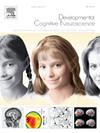婴儿期早产儿脑结构-功能耦合过度发育
IF 4.9
2区 医学
Q1 NEUROSCIENCES
引用次数: 0
摘要
尽管在婴儿期大脑结构和功能的快速增长已经有了充分的记录,但对于这两种发育过程是如何相互作用的——这方面在成人大脑中表现出不同的模式——所知相对较少。在这项研究中,来自dHCP数据库的多模态MRI数据被用来研究婴儿大脑结构和功能之间的耦合,特别关注早产如何影响这种关系。在早产儿和足月婴儿之间的耦合分布模式类似,耦合指数在单峰皮质(如视觉和感觉运动区域)和跨峰皮质(包括默认模式网络)之间变化。值得注意的是,在足月等值年龄的早产儿中发现了结构-功能耦合的普遍过度生长和向足月婴儿的缓慢发育轨迹。总的来说,该研究量化了早产儿结构-功能关系的发展,为早期大脑的信息传递过程和发育模式提供了新的见解。本文章由计算机程序翻译,如有差异,请以英文原文为准。
The overgrowth of structure-function coupling in premature brain during infancy
Although the rapid growth of brain structure and function during infancy has been well documented, relatively little is known about how these two developmental processes couple—an aspect that exhibits distinct patterns in adult brain. In this study, the multimodal MRI data from the dHCP database were used to investigate the coupling between brain structure and function in infants, with a particular focus on how prematurity influences this relationship. A similar pattern of the coupling distribution between preterm and full-term infants was identified with coupling index varying across unimodal cortices such as visual and sensorimotor regions and transmodal cortices including default mode network. Notably, a widespread overgrowth of structure-function coupling and a slow developmental trajectory towards full-term infants in preterm infants at term-equivalent age were found. Collectively, the study quantified the development of structure-function relationships in preterm infants, offering new insights into the information transmission processes and developmental patterns of the early-life brain.
求助全文
通过发布文献求助,成功后即可免费获取论文全文。
去求助
来源期刊

Developmental Cognitive Neuroscience
NEUROSCIENCES-
CiteScore
7.60
自引率
10.60%
发文量
124
审稿时长
6-12 weeks
期刊介绍:
The journal publishes theoretical and research papers on cognitive brain development, from infancy through childhood and adolescence and into adulthood. It covers neurocognitive development and neurocognitive processing in both typical and atypical development, including social and affective aspects. Appropriate methodologies for the journal include, but are not limited to, functional neuroimaging (fMRI and MEG), electrophysiology (EEG and ERP), NIRS and transcranial magnetic stimulation, as well as other basic neuroscience approaches using cellular and animal models that directly address cognitive brain development, patient studies, case studies, post-mortem studies and pharmacological studies.
 求助内容:
求助内容: 应助结果提醒方式:
应助结果提醒方式:


